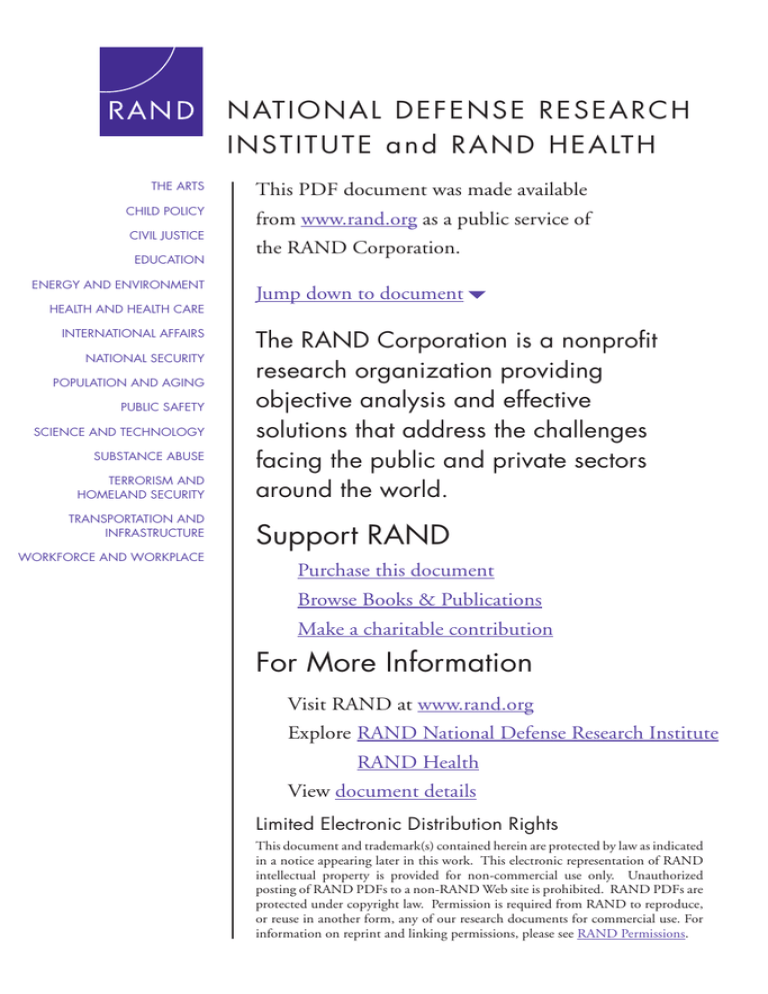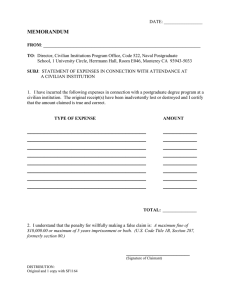
NATIONAL DEFE N S E R E S E A R C H
INSTITUTE and R A N D H E A LT H
THE ARTS
This PDF document was made available
CHILD POLICY
from www.rand.org as a public service of
CIVIL JUSTICE
EDUCATION
ENERGY AND ENVIRONMENT
HEALTH AND HEALTH CARE
INTERNATIONAL AFFAIRS
NATIONAL SECURITY
POPULATION AND AGING
PUBLIC SAFETY
SCIENCE AND TECHNOLOGY
SUBSTANCE ABUSE
TERRORISM AND
HOMELAND SECURITY
TRANSPORTATION AND
INFRASTRUCTURE
WORKFORCE AND WORKPLACE
the RAND Corporation.
Jump down to document6
The RAND Corporation is a nonprofit
research organization providing
objective analysis and effective
solutions that address the challenges
facing the public and private sectors
around the world.
Support RAND
Purchase this document
Browse Books & Publications
Make a charitable contribution
For More Information
Visit RAND at www.rand.org
Explore RAND National Defense Research Institute
RAND Health
View document details
Limited Electronic Distribution Rights
This document and trademark(s) contained herein are protected by law as indicated
in a notice appearing later in this work. This electronic representation of RAND
intellectual property is provided for non-commercial use only. Unauthorized
posting of RAND PDFs to a non-RAND Web site is prohibited. RAND PDFs are
protected under copyright law. Permission is required from RAND to reproduce,
or reuse in another form, any of our research documents for commercial use. For
information on reprint and linking permissions, please see RAND Permissions.
This product is part of the RAND Corporation monograph series.
RAND monographs present major research findings that address the
challenges facing the public and private sectors. All RAND monographs undergo rigorous peer review to ensure high standards for
research quality and objectivity.
Maintaining Military
Medical Skills
During Peacetime
Outlining and Assessing
a New Approach
Christine Eibner
Prepared for the Office of the Secretary of Defense
Approved for public release; distribution unlimited
NATIONAL DEFENSE RESEARCH INSTITUTE and
RAND HEALTH
This research was sponsored by the Director of Program Analysis and
Evaluation and the Assistant Secretary of Defense for Health Affairs. It
was conducted jointly by the RAND Health Center for Military Health
Policy Research and the Forces and Resources Policy Center of the RAND
National Defense Research Institute. The latter is a federally funded
research and development center sponsored by the Office of the Secretary of Defense, the Joint Staff, the Unified Combatant Commands, the
Department of the Navy, the Marine Corps, the defense agencies, and the
defense Intelligence Community under Contract W74V8H-06-C-0002.
Library of Congress Cataloging-in-Publication Data
Eibner, Christine.
Maintaining military medical skills during peacetime : outlining and assessing a
new approach / Christine Eibner.
p. cm.
Includes bibliographical references.
ISBN 978-0-8330-4291-0 (pbk. : alk. paper)
1. Medicine, Military—United States. 2. Manpower planning—United States.
3. United States. Dept. of Defense—Personnel management. I. Title.
UH223.E415 2008
355.3'45—dc22
2007052734
The RAND Corporation is a nonprofit research organization providing
objective analysis and effective solutions that address the challenges
facing the public and private sectors around the world. R AND’s
publications do not necessarily reflect the opinions of its research clients
and sponsors.
R® is a registered trademark.
© Copyright 2008 RAND Corporation
All rights reserved. No part of this book may be reproduced in any
form by any electronic or mechanical means (including photocopying,
recording, or information storage and retrieval) without permission in
writing from RAND.
Published 2008 by the RAND Corporation
1776 Main Street, P.O. Box 2138, Santa Monica, CA 90407-2138
1200 South Hayes Street, Arlington, VA 22202-5050
4570 Fifth Avenue, Suite 600, Pittsburgh, PA 15213-2665
RAND URL: http://www.rand.org
To order RAND documents or to obtain additional information, contact
Distribution Services: Telephone: (310) 451-7002;
Fax: (310) 451-6915; Email: order@rand.org
Summary
This monograph examines the feasibility of a new model for maintaining the clinical skills of the military medical force. Under the model,
active-duty personnel would be assigned to civilian settings during
peacetime. The study on which this monograph is based explored the
feasibility of this model from a civilian perspective, focusing on civilian
receptiveness to the proposed arrangement and identifying potential
barriers and concerns. The study found that civilian medical organizations are generally receptive to the idea of such a model and that DoD
could consider conducting a pilot study to assess the effectiveness of the
model in improving military medical readiness.
Background
Currently, most military medical personnel are stationed at military
treatment facilities (MTFs), where they maintain their clinical skills by
treating beneficiaries of TRICARE, the military health care program.
Yet the medical skills required during deployment are likely to differ
significantly from those required in MTFs. Specifically, the most frequent diagnoses during deployment relate to wounds, fractures, and
acute conditions such as febrile illness. By contrast, the most frequent
diagnoses at MTFs relate to obstetric care and conditions associated
with aging.
Consequently, alternative arrangements for maintaining medical
skills for deployment may be needed. One alternative would be to station some military medical personnel in nonmilitary settings in which
ix
x
Maintaining Military Medical Skills During Peacetime
the case mix more closely resembles the expected case mix under deployment, such as emergency rooms or trauma centers. For the model to
work, civilian organizations must be willing to accommodate military
medical personnel despite the risk of deployment and—preferably—to
share the cost with DoD. Would civilian medical organizations accept
this partnership?
Study Purpose and Approach
This analysis explored the feasibility of using DoD medical personnel
in nonmilitary medical settings, focusing on the civilian perspective.
We conducted the analysis in two steps. First, we worked with DoD’s
Office of Program Analysis and Evaluation to develop a straw-man scenario under which DoD personnel could be stationed at civilian facilities. This model proposed a five-year initial period of service that would
follow graduate medical education. Once medical personnel entered
military service, they would be stationed at civilian locations on a semipermanent basis. During a typical year, medical personnel would be at
their civilian stations for approximately eight months and deployed for
day-to-day operations or in military-specific training for four months.
Second, we used the straw-man model to gauge civilian reactions to the
proposed arrangement. To do this, we interviewed nine civilian health
care organizations to determine their willingness to consider the proposed arrangements. The interviews focused on concerns about potential deployment, malpractice liability, cost sharing, compensation, and
workforce management issues.
Findings
The analysis found that civilian organizations overall had positive
views about accommodating DoD personnel and would be willing to
consider sharing the cost of assigning military health care providers
to civilian facilities. Civilian organizations felt that the model made
the most sense for occupations that perform acute, short-term care. In
Summary
xi
general, the civilian organizations thought that the model was feasible.
However, three reservations about feasibility emerged: (1) if the civilian
counterpart job is unionized, the model would be difficult to implement; (2) enlisted DoD medical personnel are occasionally given more
responsibility than their civilian counterparts are legally allowed; and
(3) the labor market for enlisted medical occupations can be relatively
slack. The study results also indicated the following:
• The risk of deployment and liability issues were, somewhat surprisingly, not a major concern.
• Of greater concern were personnel policy issues. In particular,
some respondents wondered whether civilian organizations could
exert sufficient control over military personnel and accept or reject
specific appointments based on organizational needs.
• Three additional questions about personnel policy also arose:
Would civilian employers be able to discipline or fire military
employees who were not performing adequately? How would
legal issues such as sexual harassment and workers’ compensation
be handled? Would civilian employers have the flexibility to reallocate DoD personnel across geographic locations as needed?
• All the organizations except one (a fire department) expressed a
willingness to share the cost of using military medical personnel.
There were concerns, however, about the complexity of compensation under dual-payer arrangements. There were also concerns
about whether the civilian organizations would need to share the
costs of benefits as well as salaries.
Potential Advantages and Disadvantages to DoD
Adding a new category of health care providers—active-duty personnel stationed at civilian facilities—can contribute to readiness. This
new category could also increase the military’s flexibility by allowing
DoD to employ virtually any mix of medical personnel without having
to sustain them in MTFs. This flexibility would be useful for employing specialties or maintaining skills that are required for deployment
xii
Maintaining Military Medical Skills During Peacetime
but are seldom used to fulfill DoD’s benefits mission. Although reservists can provide this flexibility to a degree, there is no guarantee that
the work that reservists are doing in their civilian jobs matches the
skills required by DoD during deployment. Further, active-duty personnel stationed in civilian settings could be called up more easily than
reservists.
While this increased flexibility represents a benefit, the new category of providers could also increase DoD’s costs. If MTF providers
currently engaged in beneficiary care are shifted to the civilian sector,
DoD would have to expend more resources replacing the care they
would otherwise provide to TRICARE beneficiaries, perhaps by turning to the civilian sector. The study found that civilian organizations
may be willing to provide permanent-duty stations for military medical personnel and that they may even be willing to cost share for these
personnel. If so, this cost sharing would at least partially offset additional costs that DoD might incur under the new model, making it
more attractive from DoD’s standpoint.
Given the relatively positive reaction of civilian organizations,
DoD could consider conducting a pilot study to assess the model’s
effect on readiness, retention, and morale and to determine whether
the benefits of the program appear to outweigh the costs. We anticipate
that a meaningful pilot study would involve at least five to seven civilian sites, allowing DoD to have sufficient perspective on the hurdles
and contingencies that might arise when negotiating contracts with
civilian organizations.




